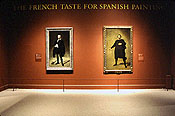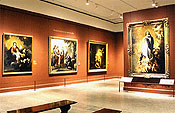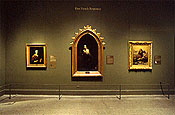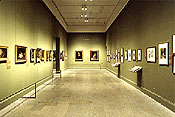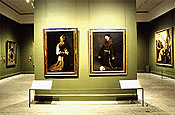X
Please wait for the PDF.
The browser will either open the file, download it, or display a dialog.
The browser will either open the file, download it, or display a dialog.
|
"Manet / Velázquez: The French Taste for Spanish Painting" |
||||||||
|
The thrilling pair of paintings that greeted the visitor to "Manet / Velázquez: The French Taste for Spanish Painting" at the Metropolitan Museum of Art set the tone for a magnificent visual tour through two different centuries, cultures, and—despite the argument by the curators Gary Tinterow and Geneviève Lacambre to the contrary—ways of painting. Hung side by side in an ample vestibule, Manet's The Tragic Actor (Rouvière as Hamlet, 1865–66; National Gallery of Art, Washington, D. C.) and Velázquez's Pablo de Valladolid (ca. 1632–35; Prado, Madrid) had the same reverse chronological order as the title, which signaled that the show was concerned with nineteenth-century French modernism (fig. 1). The opening text stated that the exhibition would "chart the means by which French collectors and museums acquired Spanish works and the ways in which French artists came to understand, appreciate, and emulate Spanish Golden Age painting." The new taste for Spanish seventeenth-century painting by French nineteenth-century painters, collectors, and critics was then fitted into modernism's canonical shifts: from Italian to Spanish art, from Renaissance to baroque painting, from idealism to realism, from porcelain-like surfaces to the sketch aesthetic of impressionism. | |||||||
| The quality of the art did not taper off in the following nine galleries. A lengthy and copiously illustrated catalogue accompanied the exhibition; the longer English version reflects the additional works shown in New York (see my review of the catalogue in this issue of 19th-Century Art Worldwide). Thanks to the sponsor Accenture, the Metropolitan Museum also created a website for the exhibition (via www.metmuseum.org), on which one can see images of the Prado museum as a nineteenth-century artist might have seen it, and make additional comparisons between the Spanish and nineteenth-century pictures in the exhibition. | ||||||||
| "Manet / Velázquez" offered a new visual experience—direct comparisons between Spanish seventeenth- and French nineteenth-century paintings from various collections—but no new ideas. The French discovery of Spanish painting and the impact of the Spanish Gallery in the Louvre museum on French modernist painting had already been the subject of nineteenth-century aesthetic discourse. These arguments were then elaborated upon by twentieth-century scholars, such as Ilse Hempel Lipschutz (Spanish Painting and the French Romantics, 1972), Jeannine Baticle and Cristina Marinas (La Galerie Espagnole de Louis-Philippe au Louvre, 1838–1848, 1981), and Joel Isaacson (Manet and Spain. Prints and Drawings, exh. cat., 1969). | ||||||||
| Moreover, three recent exhibitions devoted to nineteenth-century interest in Spain and Spanish art offered fresh examinations of the topic. The Musée Goya in Castres organized two shows with catalogues, Les peintres français et l'Espagne. De Delacroix à Manet (1997) and Velázquez et la France. La découverte de Velázquez par les peintres français (1999), which present many unfamiliar works by lesser-known artists who traveled to Spain or studied Velázquez's paintings. In the 1993 exhibition catalogue Spain, Espagne, Spanien. Foreign Artists Discover Spain, 1800–1900, edited by Suzanne Stratton (New York: The Spanish Institute), I challenged this traditional argument that nineteenth-century French artists "discovered" and had special insight into Spanish art. In that essay, I examined the French literary traditions of an exotic, different Spain, the citations of later French authors who perpetuated this characteristic imagery of Spain, the dependence of French artists on French authors to formulate their expectations of Spain and Spanish art, and the role of tourism on French artists' decisions to visit and represent Spain. | ||||||||
| What the exhibition did achieve for the first time was to gather an impressive group of relevant masterpieces by Spanish seventeenth-century painters, and Goya, along with those by French nineteenth-century artists. This logistical and financial feat could only have been realized through the cooperation of three major museums holding many of the key works: the Museo del Prado, the Musée d'Orsay, and the Metropolitan Museum of Art. Curiously, the Prado did not take the exhibition (instead, it mounted a show devoted to Manet). The Metropolitan expanded the Musée d'Orsay's version of the show, with twice the number of Spanish paintings and a substantial number of American nineteenth-century paintings. | ||||||||
| The hanging of the vestibule and that of the first gallery demonstrated the two different methods of persuasion used by the curators: confrontation and recall, or, the one-to-one comparison of "source" and "interpretation"; and the accumulated memory of relevant images on later artistic production. Since an original work of art cannot be in two places at once, the curators had to choose between hanging rooms thematically or by making formal comparisons; they favored the first approach, but there were selective comparisons, mostly in rooms with several works by the same artist, for example, Goya and Manet. For cases in which the work to be compared hung elsewhere in the exhibition, a small black-and-white reproduction on the wall panel stood in for the original. | ||||||||
| The first gallery, quite large, presented a range of Spanish seventeenth-century paintings that were documented to have been in France in the early part of the nineteenth century; it underscored the organizers' belief that collecting and public museums were critical in forming this aesthetic taste. The organizers emphasized the importance of the Prado museum, which opened in 1819, for the foreign reception of old master Spanish painting. In their own institutions, the curators at both the Prado and the Metropolitan found "panoramic" photographs of the Prado's nineteenth-century installations, one of which figured in the exhibition. Such documents of museum display during the 1800s are rare. | ||||||||
| From the small female portrait, now attributed to Claudio Coello (late seventeenth century; Musée Ingres, Montauban) but called a Velázquez when Ingres acquired it in Rome before 1818, to Velázquez's Democritus (ca. 1629; Musée des Beaux-Arts, Rouen), considered to be by Ribera until the 1880s, the visitor could perceive the unsteady basis of much French knowledge about Spanish painting during the nineteenth century. Still, the organizers claimed that "direct contact with Spanish painting (sometimes mediocre or not even Spanish) inspired French artists and the triumph of Realism." But faced with paintings that can no longer be considered Spanish—such as the Dead Soldier (The National Gallery, London) then given to Velázquez and a likely source for Manet's Dead Toreador (1863–64; National Gallery of Art, Washington, D.C.)—the visitor must have wondered what the curators meant by "knowledge" of Spanish art or its "influence." | ||||||||
|
Spain itself did not figure in this art-historical narrative; it had only a passive role as the object of French desire. However, evidence exists that many Frenchmen who acquired Spanish paintings in Spain depended on Spanish scholarship and/or contacts to locate and purchase (or pillage) them. This information must be integrated into our understanding of how French taste for Spanish art was shaped. Among these private collectors were military men like Marshal Soult, who came to Spain during the Napoleonic occupation of 1808–14, and Baron Taylor, who came during the French Bourbon intervention of 1823 and the Orléans intervention of 1834–35. These men not only had political and economic advantages that allowed them to acquire art in Spain, but the arriviste Marshal Soult amassed a more authentic group of Spanish paintings than did experienced connoisseurs, an irritating fact that troubles the exhibition's notion of taste and how it is formed (fig. 2). | |||||||
| The Napoleonic invasion of the Iberian Peninsula from 1807–14 may have been an embarrassment to the organizers—as it was to contemporary French liberals—because it is not well explained here. Non-specialists of my acquaintance did not follow the connection between Soult's collecting and the French invasion and occupation of Spain, briefly explained on a wall panel. Similarly glossed over is the illegality of the formation of the Spanish Gallery—a collection of more than 400 paintings exhibited in the Louvre from 1838 to 1848—by secret agents of the French king Louis-Philippe. The covert acquisitions in Spain by these agents, Baron Taylor and the artist Adrien Dauzats, were partly determined by location (chosen for ease of smuggling canvases out of Spain), price, and time, especially after Spanish officials became aware of their activities. The French appreciation for Spanish Golden Age painting that has long been ascribed to the Galerie Espagnole had everything to do with the political and economic circumstances in Spain that made such art available in relatively large quantities for relatively modest prices, much more than it had to do with pre-existing taste. | ||||||||
|
The second, small gallery, "First French Responses," offered an eclectic mix of copies and original subjects by artists from around 1820 to 1850 (excluding Courbet). The copies by Chassériau (1838; private collection) and Delacroix (1824–27; Musée des Beaux-Arts; Béziers), after what were thought to be Spanish seventeenth-century paintings, might have been better understood with some historical context for the practice of copying the old masters in nineteenth-century artistic training. The inclusion of François Gérard's St. Theresa (1828; Maison Marie-Thérèse, Paris) (fig. 3) begged the question: if only one work in an artist's oeuvre is known or seen to have been influenced by Spanish art—here, for its "intensity of the saint's expression and the dramatic chiaroscuro"—can we call this "influence" or "taste," or would the terms "fashion" or "fad" be more appropriate? The confrontational, even sexual character of this picture could have been addressed to distinguish it from Spanish representations of this Spanish saint. Furthermore, Millet's absolutely rigid Virgin of Loreto (1851; Musée des Beaux-Arts, Dijon) is wholly unlike Murillo's supple figures, while in his Assumption of St. Barbara (1841; Musée des Beaux-Arts, Angers), the grotesque hand and rough, pasty brushwork more resemble those of late Goya, than Ribera. | |||||||
|
The next small room, "Goya and France," surveyed what French artists knew of and borrowed from Goya's art, particularly the print series Los Caprichos, originally published in 1799 (fig. 4). As the organizers argued primarily for the impact of Spanish painting and painting technique, the prints are tangential at best. | |||||||
| The large fourth and fifth galleries, "Spanish Paintings in France at Mid-Century," with their inclusion of works by such French modernists Manet, Degas, and Courbet, provided the climax of the exhibition as well as the primary material for its argument. The Spanish Gallery was the largest, highest quality, and most public collection of Spanish painting to be seen in nineteenth-century France, and it has long been believed to have profoundly impacted these avant-garde French painters. Yet neither the promising quotation from Baudelaire about the Galerie Espagnole—"it increased the general volume of ideas you had to have about painting"—nor the chronological lag between the 1848 closing of the Spanish Gallery and the significantly later production of nearly all the French modernist paintings was explored. | ||||||||
| More disappointing was the organizers' surface treatment of the principal visual (especially technical) consequences that this taste for Spanish painting is said to have had on nineteenth-century French art. A singular opportunity was missed here to sensitize, educate, and challenge visitors to greater visual perception and thus historical analysis, in front of the sources of influence as well as their modernist and more conservative nineteenth-century interpretations. This was the rare exhibition, with such a high caliber of loans, that could have supported a serious investigation of "influence," the way it worked in the nineteenth century, and how certain artists, like Manet and Degas, transformed traditional references to the old masters. Instead, visitors got the same comparisons between the same artists published years ago, without any significant contributions. | ||||||||
| For example, the well-known and still stunning juxtaposition of Manet's Monk at Prayer (1864–65; Museum of Fine Arts, Boston) with Zurbarán's St. Francis in Meditation (ca. 1635–40; National Gallery, London) received only the most superficial analysis (fig. 5). Here the curators did point out a difference: Manet changed the original position of the monk's head, making the figure quite unlike that in Zurbarán's picture. However, they did not offer any possible significance for the change, and the public might just have assumed that Manet was trying not to copy exactly. They might have discussed how Manet's downward glancing figure conveys a more earthly thought, while the slightly upturned face of Zurbarán's figure was a conventional sign of spiritual belief or ecstasy. Also, the head of St. Francis appears shrouded in shadow, creating a mysterious, even menacing impression, which could have launched an exploration of seventeenth- and nineteenth-century interpretations of Zurbarán's painting as deeply pious, even frightening in its spiritual intensity. Manet's canvas, on the other hand, did not convey religious expression to his contemporaries. Moreover, the brushwork of the two artists is visibly different. Manet's paint is unctuous and creamy, reinforcing the flatness of the canvas, while Zurbarán's is thicker and drier, and his figure appears much more powerfully modeled in three dimensions. | ||||||||
| Too often, one read catch phrases on the wall panels like "masterful brushwork" to link a French modernist with a Spanish old master, without further analysis. In the vestibule's duel between Manet and Velázquez, visible differences in technique could have been fruitfully analyzed and explained. Manet's black paint glistens in separate and visible touches on the surface, entirely different from Velázquez's matte, continuous, and rather flat black tones. Manet could not have learned to paint his blacks from Velázquez. In modeling the figure's hands, Manet applied distinct strokes of lights and darks that break up the surface and flatten the forms; this contrasts with the more integrated chiaroscuro and illusionistic modeling of the hands painted, however broadly, by Velázquez. The former is a modernist approach that begins to divorce the signifier (brushstroke) from the signified (form), while the Spaniard's technique here followed conventional figurative painting practice. | ||||||||
| Moreover, not all loose or "masterful" brushwork is the same, even among the Spanish old masters. Consider the blue cloak of the principal figure in Ribera's St. Sebastian Tended by the Devout Women (c. 1621–31; Museo de Bellas Artes, Bilbao), in which the brown ground shows through the roughly applied blue paint to suggest shadow in the folds, and whitish scumbling over the blue indicates highlights. This loose or rough brushwork helps to model the saint's figure, without challenging its legibility or the narrative, as it would in a modernist canvas. Ribera's facture is unlike that of Manet or of Ribot (whose Torture of Alonso Cano 1865 is seen as influenced by Ribera's painting), but might be compared to Degas's scratchy brushwork. And the wall panel cited Charles Blanc's description of the St. Sebastian, "the skin is so realistically rendered that it seems palpable," without further explanation, a common problem with any reference to "realism" (capitalized or not): once the term is used, it shuts down further discourse, for it is assumed to be transparent, to mean the same thing to everyone. | ||||||||
| The sixth gallery, "Spain as Subject / French Realists," segregated certain painters—Dehodencq, Ribot, Legros, Regnault—from the other realists (Courbet, Manet, Degas) in the preceding room, despite the fact that they all painted Spanish subjects. The division here had to do with value judgments: the artists in the seventh gallery are generally considered less original, more academic, or second rate. Nevertheless, Alfred Dehodencq's Bullfight in Spain (1850; Musée des Beaux-Arts, Pau) attracted much attention from some of these "modernists," and Antonin Proust claimed that Manet considered it the truest picture of Spain he had ever seen. In the same room, Goya's extraordinary Black Paintings were mentioned as having been exhibited in Paris at the 1878 Universal Exposition, but those darkly fantastic paintings seem more likely to have affected the emergent symbolists than the brushwork of the impressionists. | ||||||||
| A small seventh gallery devoted to Velázquez's influence was surprisingly dull, despite containing variations on the interesting theme of the artist in his studio by Corot, Manet, and Degas. These small canvases had to compete against the large works of the two preceding rooms, and overcome the absence of paintings by Velázquez, other than the Louvre's Petits Cavaliers (which not all scholars accept as even a workshop piece). Only Las Meninas would have made sense here, and this fabulous painting the Prado will not lend. | ||||||||
| The eighth, spacious gallery was devoted to the works of American painters. Only Mary Cassatt's pictures were split between two rooms: In the Loge (formerly known as Woman in Black at the Opera, 1877–78; Museum of Fine Arts, Boston) was hung with works by Degas and Manet, but it looked out of place near the Spanish old masters as her early Spanish genre paintings did next to Whistler's full-length portraits in the American room. The reasoning behind the inclusion of American artists in a show about French taste is that the American artists who studied in France also absorbed the French taste for seventeenth-century Spanish art. None of the American responses to Spanish art and culture that existed prior to 1850—Washington Irving's writings or the hosting of Spanish paintings at the Pennsylvania Academy of Art—are discussed, as though no American perspective existed. In view of such diverse works by artists of distinct training, aims, and means of expression as Whistler and Eakins, the visitor might have left the exhibition wondering whether every artist working or studying in nineteenth-century France was "influenced" by Spanish Golden Age painting. | ||||||||
| A small side gallery with computer terminals to access the exhibition website also displayed Manet's prints related to Spanish themes. The discontinuity with the artist's other works made this room seem like an afterthought, and, like the Goya room, its graphic emphasis diverged from the organizers' argument that Spanish seventeenth-century painting had a catalyzing effect on modernist painting, especially its technique. | ||||||||
| Despite these criticisms, visitors who attended the show surely reveled in the superb quality of the art on view, and for those unfamiliar with the scholarly literature, the exhibition adequately surveyed a large, complex topic. Specialists, however, found that it neither advanced their understanding of the factors driving this aesthetic taste, nor did it fully exploit the visual potential and intellectual challenge of comparing pictures by such different painters and cultures. | ||||||||
| Alisa Luxenberg Associate Professor of Art History University of Georgia, Athens |
||||||||


